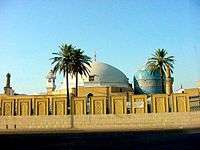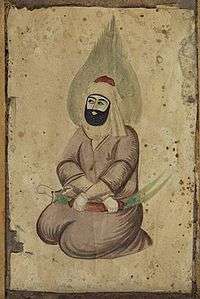Nūr (Islam)
| |
|---|
 |
|
Lists |
|
|
Nūr (Arabic: النور) may refer to the "Light of God" or the "Muhammadan Light" in Islam. The word "nūr'" means "light" in Arabic, Persian and Urdu. It is often used in the Quran, notably in a verse that states "God is the light of the heavens and the earth", which has been the subject of much discussion. Many classical commentators on the Quran considered that this should be taken metaphorically, as in the sense that God illuminates the world with understanding, rather than literally. The Andalusian scholar Abu Bakr ibn al-Arabi categorized nūr into different levels of understanding from the most profound to the most mundane. Shias consider that nūr in the sense of inner, esoteric understanding is inherited through the Imams, who in turn communicate it to the people.
The Sufis consider that light was created first, then all other beings and things were created from it. There is controversy over the doctrine of An-Nūr al-Muḥammadī, or the Muhammadan Light, in which Muhammad is thought to have existed before creation. Sufis in medieval Bengal developed the concept into detailed narratives of the way in which the world came into being from nūr. The Nur movement in modern Turkey, evolved from Sufi concepts, emphasizes inner understanding and control.
Quran
The word nūr comes from the same root as the Hebrew aor, the primal light described in the Book of Genesis that was created at the beginning.[1] The word nūr, or its derivatives, occurs forty-nine times in the Quran. It is used in reference to God, Muhammad, the Quran, the Book, the Torah, the moon and the faithful men and women. Al-nur is often used in combination with zulumat (darkness) in terms that describe movement from darkness into light, and from ignorance into faith.[2] The word nūr is also used in eight basic referential meanings:[3]
- The religion of Islam
- Faith
- God's commandments and moral laws in the Torah and the Gospels
- The light of day
- The guiding light that God will give to the faithful on the Day of Resurrection
- The commandments and injunctions of the Quran
- Justice
- The light of the moon
The mystical Sura 24 of the Quran contains the Ayat an-Nur, the Verse of Light (Q24:35), which reads, "God is the light of the heavens and the earth; the likeness of His light is as a niche wherein is a lamp (the lamp in a glass, the glass as it were a glittering star) kindled from a Blessed Tree, an olive that is neither of the East nor of the West whose oil well nigh would shine, even if no fire touched it; light upon light; (God guides to His light whom he will.)"[4] The phrase "light upon light" (nurun 'ala nur) in this sura is often used among Muslims to denote the infinite beauty, guidance and light of God.[2]
Classical commentaries
Most classical commentators other than Sufis took the statement "God is the light of the heavens and the earth" as a metaphor, and considered that God should not be literally equated with the natural phenomenon of light. Al-Tabari (839–923) in his Jami al-bayan says that the best interpretation is to substitute "guide" for "light", as "God is the guide of the heavens and the earth". Other interpretations make God the source of illumination rather than the light itself, as "God lights the heavens and the earth.[5] The Persian scholar Al-Zamakhshari (c. 1074 –1144) says that the phrase "God is the light" is like saying "Zayd is generous and munificent". This does not mean that Zayd is the properties of generosity and munificence, but that he has these properties. Al-Zamakhshari rejected the possibility of attributes separate from God, such as power or knowledge or light, which would be contrary to the unity of God.[5] He interpreted "God is the light of the heavens and the earth" as meaning,
He is the possessor of the light of the heavens and the owner of the light of the heavens. The light of the heavens and the earth is the truth (al-ḥaqq), which can be compared to light in its manifestation and clarification, just as he says, "God is the friend of those who believe; He brings them forth from the shadows to the light (2:257), i.e., from the false to the true (al-ḥaqq).[5]
Al-Ghazali (c. 1058–1111) wrote a treatise on how different types of light should be defined, and how the phrase "God is the light of the heavens and the earth" should be interpreted. In his view, "light" can have three different meanings. The first is the ordinary usage, "an expression of what can be seen in itself and through which other things can be seen, like the sun". In Arabic the word "light" may also refer to the eye, through which perception takes place, and this may be a more appropriate interpretation.[6] The "eye" of the intellect is an even more perfect organ of perception, and "light" may be used to refer to this organ. In this sense "light" may refer to Muhammad, and to a lesser extent to the other prophets and religious scholars. A third interpretation is that "light" is the first light (al-nūr al-awwal) and the real light (al-nūr al-ḥaqq) since it is the only light that does not take its luminosity from some other source. God is light, the only light, the universal light, and he is hidden from mortals because he is pure light, although he is omnipresent. Using the term "light" for any other purpose is metaphor.[7]
Another passage of the Quran states "The earth will shine with the light of its Lord" (Q39:69). Mainstream exegetes take this statement literally. Exegetes of the rationalist Mu'tazila school of theology of the 8th–10th centuries interpreted the word nūr in this passage in the sense of "the truth, the Quran and the proof" rather than the commonplace meaning of "light".[8] Shia exegetes take it to mean "the land of the soul will shine with the Lord's light of justice and truth during the time of Imam al-Mahdi." Sufi exegetes take nūr in this case to mean "justice", or take the statement to mean "God will create a special light to shine on the Earth".[9]
Shia belief
The adherents of Shia Islam believe that divine guidance continues to reach mankind through the progeny of Muhammad. The Imams have the function of conveying the inner, esoteric understanding to mankind. According to Nadia Eboo Jamal, the Imams are "the inheritors of his spiritual knowledge ('ilm), the bearers of the light (nūr) of God and His living proof (hujjah) on earth."[10]
According to the fifth Shiite Imam, Muhammad al-Baqir, the imams are the muḥaddathūn that are mentioned in the Quran, and are the light of God (nūr Allāh).[11] He was asked to comment on the Quranic verse Q44:8, "And believe in Allah and His Messenger and the nūr (light) that We have brought down." He replied that the imams from the Prophet's family were in fact the light of God (nūr Allah) in the heavens and on earth. This spiritual light, passed down from one generation to the next, symbolizes the eternal knowledge that Muhammad passed on to Ali and his descendants.[12]
There seem to be two concepts. The nūr muḥammad is passed down through genealogical descent, while the nūr Allah is inherited at the time the previous possessor dies. The imam has the nūr muḥammad at birth, but is silent until he receives the nūr Allah.[13] The nūr muḥammad is the symbol of succession and the substance that connects Adam to Muhammad and Muhammad to the imams. The nūr Allah is the symbol of prophecy, which the imams share with the prophets and all men chosen by God.[14]
Sufi interpretation
To the Sufis, nūr is the first creation of Allah, and all other things and beings were gradually created from it.[15] The Andalusian scholar Abu Bakr ibn al-Arabi (1076–1148)) elaborated the concept that Muhammad existed before creation. This is the doctrine of An-Nūr al-Muḥammadī, or the Muhammadan Light. The light existed before creation, and everything was created from it. The world is a manifestation of the light, which was incarnated in Adam, the prophets and the Aqṭāb.[16] Ibn al-Arabi wrote, "The creation began with nūr Muhammad. The lord brought the nūr from his own heart."[17] The Persian poet and Sufi theoretician Fariduddin Attar (c. 1145–1221) wrote, "The origin of the soul is the absolute light, nothing else. That means it was the light of Muhammad, nothing else."[18]
The concept of the Muhammadan light was controversial, and the scholars al-Ghazali and Ibn Taymiyyah (1263–1328) rejected the idea that Muhammad was pre-existent. Instead they interpreted the primordial creation of Muhammad as meaning only that he was predestined. Later Sufis often used the less controversial term "Muhammadan reality" (ḥagīqa Muḥammadiyya), particularly discussing the Light Verse.[19]
To the Sufis, light also represents what we know about our inner self, and darkness what we do not know.[20] Ibn Arabi distinguished three types of light: Nûr al-anwâr (The Light of lights), which reveals the absolute reality in its most transcendent aspect, anwâr al-ma'âni (The Light of the intellect) and anwâr al-tabi'â (The Light of nature).[21] The Kurdish philosopher Shahab al-Din Suhrawardi (1155–91) wrote, "Allah's essence is the original creative Light, always illuminating existence. It constantly manifests the universe and energizes it. Allah's Essential Light radiates the whole cosmos in abundant beauty and completeness. To be illuminated by this process means nothing less than salvation."[20]
Muḥammad ibn Muṣṭafá Khādimī (c. 1702–1763) writes that, "protecting the spiritual heart from worldly thoughts can be accomplished by the spiritual heart's benefiting (receiving "Fayd" (nūr [light]) from the spiritual heart of the perfect Sufi master. The spiritual luminance (Fayd) flows from one spiritual heart to another by way of love. Death of the perfect spiritual guide or his being in a distant country does not stop the flow of spiritual luminance (Fayd)."[22] According to Inayat Khan (1882–1927) the soul is like a ray of the sun. The angels, who do not have physical bodies, are made of nūr, or light, that comes from the divine Sun, the Spirit of God. All souls are made of Nur, or contain some part of that essence, which is the essence of the whole manifestation.[23]
Medieval Bengal
Hans Harder writes that in medieval Bengali Sufi cosmology the nūr muḥammad is personified. The nūr, created by the lord, in turn brought the world into existence from drops of perspiration (gharma, ghām) that appeared in different parts of his body.[24] He says the concept is common in Maijbhandari writings, often used to describe the saints or their sensual qualities.[24] Gholan Morshed wrote an article that identified nūr with Muhammad.[24] In his Is'lāmī prabandha sambhār he wrote that nūr-i muḥammadī is the moving force behind all creation, and should not be seen as separate from Muhammad.[25] He wrote,
At the background [antāral] of the creation, His [Muhammad's] nūr, the nūr-i muḥammadī, is at play [līlārta] as the life-breath of the creation. This is the highest secret of the play of creation, full of science [bijňān'may]. Therefore Muhammad is not any special person, not confined to any specific country, race [jāti] or by any border. In the form of nūr-i muḥammadī, He is qualified [guņānvita] by the same quality as Allah.[25]
Lutfunnesa Hosaini wrote a treatise Tāohīd, part of which discusses the creation of the world from the time when nūr-i muḥammadī emerged to the time when Muhammad was born. She writes that the nūr-i muḥammadī was divided into four parts. From the first three emerged the pen, the book of destinies and the throne. The fourth part was divided into four. From the first three emerged the angels that held the throne, the seat of the throne, and all of the other angels.[24] The last part gave rise to the sky, the earth, heaven and hell, and to a part that then gave the light of the eyes of the believers, the light of their hearts, the light of the tawḥīd and the kalima.[24]
Lutfunnesa Hosaini gives another account with reference to a Quranic commentary named Tafsīr-i rūḥ al-kitāb. In this version nūr-i muḥammadī was also used to create the nūr of Adam, stored on his back. The angels gathered behind Adam to see the light. Adam asked the Lord to put the light on his forehead, and the angels came round to where he could see them. Adam wanted to see the light himself, and the Lord transferred it to his index finger. When Adam came down to earth, lights entered his back again, and the nūr was then passed from Adam through the backs of various men and the wombs of women down to the parents of Muhammad.[26]
Modern Turkey
Said Nursî founded the Nur movement in Turkey, stressing patience and spiritual withdrawal after the secularization program of the 1930s and 1940s had crushed revolt.[27] The adherents of the Nur movement and the Sufi orders in general consider that societal change will be enabled if individuals are redeemed. Negative feelings such as anger and shame should be controlled through inner mobilization.[28] Said Nursî's textually-based Nurcu movement evolved from the Sufi orders. According to the Nurcu leader Mehmet Kırkıncı, "the sun of Islam set down in 1925 and dawned in 1950 with the writings of Said, which enlighten the darkness of Kemalism with its light [nur]."[29]
References
- ↑ Douglas-Klotz 2005, p. 255.
- 1 2 Fatani 2006, p. 467.
- ↑ Fatani 2006, p. 468.
- ↑ Irwin 2011, p. 27-28.
- 1 2 3 Sands 2006, p. 110.
- ↑ Sands 2006, p. 115.
- ↑ Sands 2006, p. 116.
- ↑ Abdul-Raof 2012, p. 36.
- ↑ Abdul-Raof 2012, p. 148.
- ↑ Alibhai 2002, p. 3.
- ↑ Lalani 2000, p. 79.
- ↑ Lalani 2000, p. 80.
- ↑ Lalani 2000, p. 81.
- ↑ Lalani 2000, p. 82.
- ↑ Harder 2011, p. 72.
- ↑ Trimingham 1998, p. 161.
- ↑ Dehlvi 2012, p. 54.
- ↑ Dehlvi 2012, p. 53.
- ↑ Sands 2006, p. 172.
- 1 2 Douglas-Klotz 2005, p. 253.
- ↑ Yahya 1991, pp. 35–44.
- ↑ Khādimī 2005, p. 7.
- ↑ Khan 2013, p. 80.
- 1 2 3 4 5 Harder 2011, p. 73.
- 1 2 Harder 2011, p. 75.
- ↑ Harder 2011, p. 74.
- ↑ Yavuz 2003, p. 33.
- ↑ Yavuz 2003, p. 30.
- ↑ Yavuz 2003, p. 57.
Sources
- Abdul-Raof, Hussein (2012). Theological Approaches to Qur'anic Exegesis: A Practical Comparative-contrastive Analysis. Routledge. ISBN 978-0-415-44958-8. Retrieved 2014-12-15.
- Alibhai, Fayaz S. (2002). "Surviving the Mongols: Nizari Quhistani and the Continuity of Ismaili Tradition in Persia – A Reading Guide" (PDF). The Institute of Ismaili Studies. Retrieved 2014-12-15.
- Dehlvi, Sadia (2012-09-05). Sufism: Heart of Islam. HarperCollins Publishers. ISBN 978-93-5029-448-2. Retrieved 2014-12-15.
- Douglas-Klotz, Neil (2005). The Sufi Book of Life: 99 Pathways of the Heart for the Modern Dervish. Penguin Compass. ISBN 978-0-14-219635-9. Retrieved 2014-12-14.
- Fatani, Afnan H. (2006). "NUR". The Qur'an: An Encyclopedia. Taylor & Francis. ISBN 978-0-415-32639-1. Retrieved 2014-12-15.
- Harder, Hans (2011-03-08). Sufism and Saint Veneration in Contemporary Bangladesh: The Maijbhandaris of Chittagong. Routledge. ISBN 978-1-136-83189-8. Retrieved 2014-12-14.
- Irwin, Robert (2011-04-14). Memoirs of a Dervish: Sufis, Mystics and the Sixties. Profile Books. ISBN 1-84765-404-5. Retrieved 2014-12-14.
- Khādimī, Muḥammad (2005). Ethics of Islam. Hakikat Kitapevi. GGKEY:3HXN4S2CKUF. Retrieved 2014-12-15.
- Khan, Hazrat Inayat (2013-07-02). The Heart of Sufism: Essential Writings of Hazrat Inayat Khan. Shambhala Publications. ISBN 978-0-8348-2874-2. Retrieved 2014-12-14.
- Lalani, Arzina R. (2000). Early Shi'i Thought: The Teachings of Imam Muhammad Al-Baqir. I.B.Tauris. ISBN 978-1-86064-434-4. Retrieved 2014-12-15.
- Sands, Kristin (2006-07-13). Sufi Commentaries on the Qur'an in Classical Islam. Routledge. ISBN 978-1-134-21144-9. Retrieved 2014-12-15.
- Trimingham, J. Spencer (1998-05-19). The Sufi Orders in Islam. Oxford University Press, USA. ISBN 978-0-19-802823-9. Retrieved 2014-12-14.
- Yahya, Osman (1991). "Theophanies and Lights in the Thought of Ibn 'Arabi". Journal of the Muhyiddin Ibn 'Arabi Society. 10. Retrieved 2014-12-14.
- Yavuz, Hakan (2003-07-31). Islamic Political Identity in Turkey. Oxford University Press, USA. ISBN 978-0-19-534770-8. Retrieved 2014-12-14.


